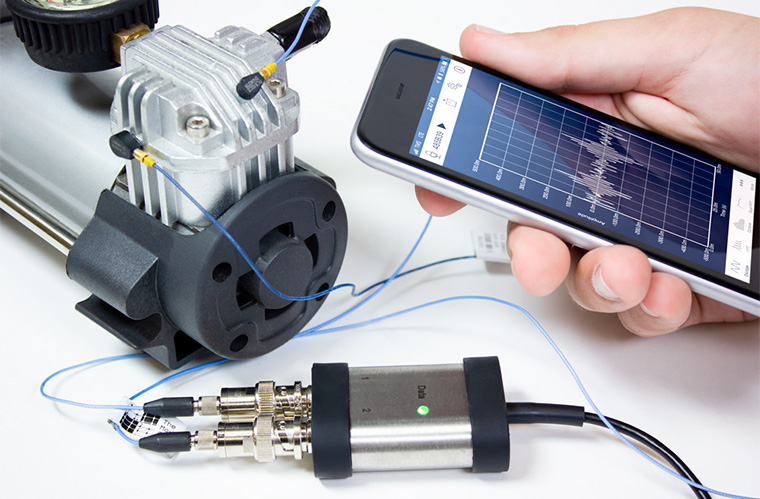Main Menu
- Home
- Product Finder
- Calibration Systems
- Calibration Services
- Digital Sensing
- Industrial Vibration Calibration
- Modal and Vibration Testing
- Non-Destructive Testing
- Sound & Vibration Rental Program
- Learn
- About Us
- Contact Us
DigiDAQ Digital ICP-USB Signal Conditioner Model 485B39, a pocket-sized, dual-channel ICP® (IEPE) digital signal conditioner, offers standard USB audio digital output. Plug & play signal conditioning makes for quick setup and intuitive functionality without the need for driver installation. The Signal Conditioner powers ICP sensors through BNC connections while digitizing their signals over USB. Simply plug the unit into a USB port and view signals from accelerometers, microphones, hammers, or any other ICP-type sensor.
 Existing third party Windows®, iOS
®, Android™, macOS®, or Linux® software can be used to acquire time waveforms, frequency spectra, overall RMS measurements, and octave measurements or simply record data for further analysis. The
small form factor, versatility, and powerful software options make this the perfect tool for taking measurements on-the-go. Whether you’re just learning about sensing; taking measurements on a daily basis; or simply want to add digital, portable
functionality to your existing sensors; the ICP – USB Signal Conditioner is a practical addition to your tool set.
Existing third party Windows®, iOS
®, Android™, macOS®, or Linux® software can be used to acquire time waveforms, frequency spectra, overall RMS measurements, and octave measurements or simply record data for further analysis. The
small form factor, versatility, and powerful software options make this the perfect tool for taking measurements on-the-go. Whether you’re just learning about sensing; taking measurements on a daily basis; or simply want to add digital, portable
functionality to your existing sensors; the ICP – USB Signal Conditioner is a practical addition to your tool set.
View Datasheet | View Specification Sheet
| Performance | ||
|---|---|---|
| Frequency Range (±5 %) | 0.8 Hz to 20.7 kHz | |
| Channel Count | 2 | |
| Voltage Range (Nominal) | ±10 V pk [1] | |
| Physical | ||
| Temperature Range (Operating) | 14 °F to 176 °F (-10 °C to +80 °C) | |
| Housing Material | Stainless Steel | |
| Excitation Voltage to Sensor (± 5 %) | 24 VDC | |
| Constant Current Excitation (± 5 %) | 4 mA | |
For a more comprehensive list of accessories, please see the Product Specification Sheet.
| Adaptor Model | Purpose |
|---|---|
| For Models with USB-A Cable | |
| USB-A to USB-C A8731 | Plug DigiDAQ into USB-C input |
| USB-A to Lightning Adaptor for Apple Devices MD821AM/A | Plug DigiDAQ into Apple lightning port |
| For Models with USB-C Cable | |
| USB-C to USB-A Adafruit 4175 | Plug DigiDAQ-C models into USB-A input |
| For Models with ICP Channel(s) | |
| Inline ICP® Charge Converter 422Exx Series | Converts ICP inputs to allow use with voltage output sensors |
V485B39 – Voltage Inputs (No ICP Supply Current)
IV485B39 – ICP (CH 1), Voltage (CH 2)